Posted: May 20th, 2016 | Author: Special Contributor | Filed under: Events | Tags: NFV, NFV World Congress, Virtualisation | No Comments »
By Stephen Lacey, Principal NFV Architect, CTO Office & Guest Author
Comptel was in attendance for the second annual NFV World Congress, held last month in Silicon Valley. Whereas the discussions at last year’s inaugural event were more academic in nature, this year’s conference showcased a number of compelling cases that demonstrate how network functions virtualisation (NFV) is taking a step toward becoming reality.
The week kicked off with a series of tutorials from the Open Networking Foundation (ONF), the European Telecommunication Standard Institute’s (ETSI) Industry Specification Group (ISG) for NFV, and the Intel Network Builders (INB) – Comptel is a proud member of the latter two groups. Throughout the week, we also observed a number of presentations from operators driving home the reasons why they are exploring NFV implementations. Two reasons stood out:
- The potential reductions in CAPEX/OPEX due to utilising ubiquitous general purpose hardware
- The ability to achieve service flexibility and mix and match services.
NFV in Action
Japanese operator NTT offered a great example of the benefits of service flexibility. During a tsunami in 2014, the need for voice traffic capacity near the storm’s epicentre increased dramatically. There was plenty of capacity in the other parts of their network, so if NFV had been available at that time, NTT would have been able to offload data capacity to other parts of the network to increase voice capacity in areas that would have needed it most.
NTT was the only operator at NFV World Congress running two different virtualised evolved package core (vEPC) vendors on live deployments: NEC and Fujitsu.
AT&T, Verizon and the bulk of the operators speaking at the event said that virtual customer premises equipment (vCPE) for enterprise-based services is the most compelling of the NFV use cases for them. When pressed, AT&T described how their customers had surprised them in the way they utilise services.
By using the AT&T ECOMP platform and EVPN as the bridging mechanisms for Layer 2 and Layer 3 switching, plus allowing their customers to chain virtual network functions together, customers enjoyed time-of-day-based services variation. For example, during the workday all branch offices had equal bandwidth to access the main datacentres, whereas after business hours those bandwidth allocations were lowered and higher bandwidth was assigned for datacentres to sync together.
Other operators said they are entrenched in NFV trials, but didn’t offer any behind-the-scenes information as to how those programs are progressing.
The Emergence of Open Source
Another important theme was the increasing mainstream relevance of open source projects, which major network equipment providers (NEPs) and communication services providers (CSPs) are relying on to prevent vendor lock-in within the network.
It seems 2016 is the year of orchestration wars, with two different open source projects exploring this aspect of network management and organization (MANO): Open Source MANO (OSM) and OPEN-Orchestrator (OPEN-O). It’s difficult to directly compare the two initiatives, since OSM is based on available software, whereas OPEN-O is only in its foundational stages.
Nonetheless, it will be interesting to keep an eye on each initiative as they progress. Comptel recently participated in a partner showcase at TM Forum Live! alongside Telefonica, Indra and Etiya which proposed a hybrid network environment based on OSM.
NFV World Congress offered a compelling venue to explore how leading operators and vendors are actively experimenting with NFV implementation. As a few pioneering telcos embrace virtualisation within the network, these first forays will carve a clear path forward for the rest of the industry. Some will take the lead; others will simply follow.
Comptel’s proposed Digital Service Lifecycle Management (DSLM) model is just one example of how we are creating new possibilities for service orchestration through NFV implementation. Download a new whitepaper from Heavy Reading to learn more about this concept, and dive into the conversation on Nexterday.org, our online magazine and reader community.
Posted: May 17th, 2016 | Author: Malla Poikela | Filed under: Events | Tags: Intelligent Fast Data, IoT, IoTNordic | No Comments »
Last month, a sold-out crowd of 500 IoT enthusiasts packed into Helsinki’s Kattilahalli conference hall for the Internet of Things 2016 Conference, also known as #IoTNordic. With a DJ playing live music throughout the two-day show, a saxophonist entertaining the crowd in the late afternoon happy hour and outdoor food vans offering tasty meals, the event offered a hip, modern and invigorating atmosphere for lively discussions on the potential and partnerships that define the IoT.
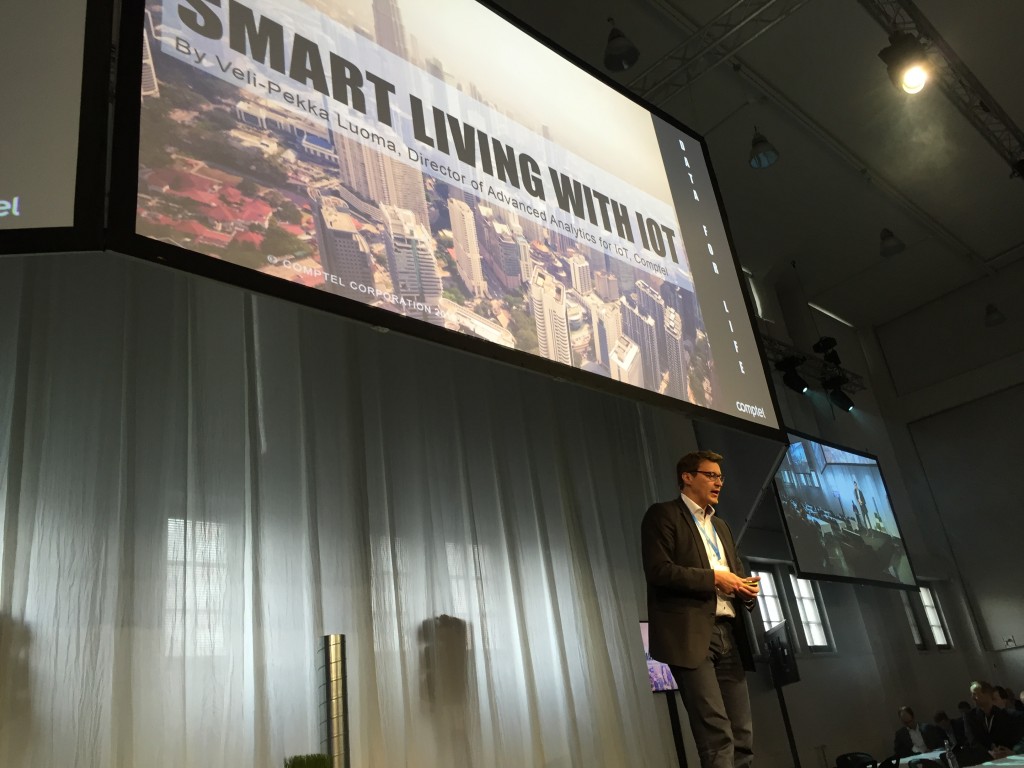
Veli-Pekka Luoma, Comptel
Although environmentalism was a major theme (event organisers used recycled wooden pallets as booth tables, for example), the event and the attendees were focused on different kind of environment: the holistic IoT ecosystem. There was one common denominator: Nearly everyone in attendance, across industries, was looking for technology partners to help them build or expand their own ecosystem of connected device solutions.
Comptel sponsored #IoTNordic and presented a speaking session with our Director of Advanced Analytics for IoT, Veli-Pekka Luoma, about the vital role data plays in the Smart Living movement. Comptel’s Intelligent Fast Data solutions offer businesses the power to sense, understand and act instantly on data “across the board.” Connected devices are another data source that produces aggregated information, alongside customer interactions, the network, social media, location and more. Businesses stand to benefit tremendously by pulling insights from all those different sources and applying insights to real-time actions. Those actions lead to better IoT-enabled experiences.
Industry can remotely monitor heavy machinery to run a “smart factory.” Health care providers can track personal data to offer intelligent preventative care, fleet managers can optimise routes for cargo vehicles, utility providers can provide efficient energy solutions with smart meters, and much more.
It all starts with smarter data. Through experimentation, partnership and solution co-creation, businesses – including operators – can apply data analytics to elevate the IoT beyond simple machine-to-machine communications toward humanistic benefits. #IoTNordic offered several compelling examples of businesses that are already succeeding in the IoT.
Elisa’s IoT Innovation Challenge
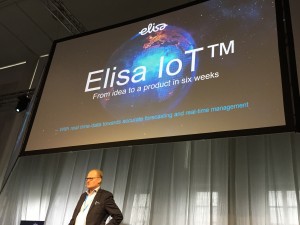
Elisa VP Markku Hollström
The Finnish operator Elisa has enjoyed many successes along its digital transformation. Its IoT service offering is one example. The company offers IoT connectivity, monitoring and analytics to a range of verticals, including a 3D real-time “Smart Factory” dashboard for industry, augmented reality solutions, and analytics-enriched monitoring and email notifications for the marine manufacturer Wärtsilä.
Elisa VP Markku Hollström explained that to succeed in the IoT, you need to experiment and develop a broad network of partners. That enables speed – the company profiled IoT projects that went from ideation to product in just six weeks. It’s also why the company is inviting businesses to participate in the Elisa Innovation Challenge, which will reward up to €85,000 in prizes to entrants who create innovative corporate and Smart Home IoT solutions.
Technology, Customer Experience the Focus for Tesla
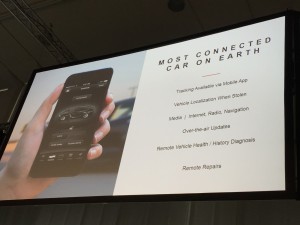
Tesla presentation at IoT Nordic
The electric car manufacturer Tesla says it is not in the business of selling luxury vehicles. At the show, the company’s speaker said the company’s focus is actually in transitioning the world toward safer, sustainable transportation. The IoT plays a big role in that: Tesla says its vehicles are the most connected cars on Earth, and their mission is to incorporate technology to create a software-based, analytics-informed driving experience. Even their car buying experience is innovative; it’s entirely online, making it a modern, customer-focused approach to purchasing.
Are Device Implants the Future of Health?
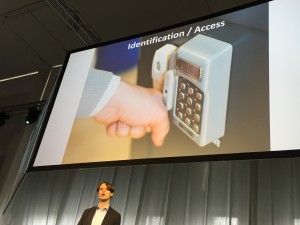
Hannes Sjöblad, BioNyfiken
Hannes Sjöblad of BioNyfiken presented a fascinating look at the role of NFC implants in human health, which his company says is humanity’s “personal key to the IoT”. This technology already exists – in fact, we saw a live demo at the end of his presentation of a human implant placed into a person’s hand. While also a bit scary, the demo did show the amazing potential of implanted devices to enable everyday individuals to “speak” to connected devices.
There are simple but very relevant use cases, like replacing keys, ID cards, tickets and boarding passes with implanted chips, and use cases that are more humanistic. Personalised chips could ensure a gun can’t be operated by an unauthorised user, for example, or even play a role in curing blindness, deafness and paralysis.
Securing the IoT
Of course, any conversation about the many uses cases for the IoT eventually falls back on security concerns. In his keynote speech, Mikko Hyppönen, Chief Research Officer of F-Secure explained that the IoT will only expand the number of threat vectors (how do you secure your Wi-Fi if it’s being shared by your refrigerator?), creating more opportunity for highly sophisticated cyber criminals and making it more difficult for consumers to maintain privacy.
The number and variety of IoT devices will make single-device protection impractical, said Hyppönen. F-Secure, for example, has no interest in developing anti-virus protection for your connected toaster. However, the company does develop full-home Wi-Fi security solutions to ensure every device on the network is secure. Furthermore, F-Secure compensates independent hackers who find holes in their security system, when many of those hackers may have otherwise sold that information to cyber criminals. It’s a good solution for F-Secure: Paying for hackers to find holes in your system is a clever and efficient way to find vulnerable spots in your environment.
As Hyppönen said, ”Web content is not free. It is paid for with your data. It’s paid for with your privacy. And it’s too late to change that. We have raised a whole new generation who are used to having content for ‘free’ on the web. And yet, we don’t understand what this means.”
That’s an important takeaway to keep in mind as businesses and operators tiptoe – or dive head-first – into the futuristic world of the IoT.
Learn more about the IoT opportunity for telco in a new whitepaper from Comptel and Heavy Reading. Download “Smart Cities & Smart Living: The Role of Telecom Operators.”
Posted: May 16th, 2016 | Author: Steve Hateley | Filed under: Compelling Cases | Tags: digital service lifecycle management, NFV, OSS/BSS, service orchestration | No Comments »
Comptel participated in several partner showcases during last week’s TM Forum Live! 2016 in Nice, France, with one in particular reimagining the model of digital service delivery for the modern B2B and B2C customer.
As Comptel CTO Simon Osborne explained, Comptel partnered with IBM and Juniper Networks in an IBM Cloud-Based Networking architecture. The project introduces new strategies for leveraging software-defined networks (SDN) and network functions virtualisation. As a result, operators can efficiently automate and reconfigure parts of their network to enable automated, self-service digital service delivery. As part of the partnership, we’re contributing our Digital Service Lifecycle Management (DSLM) model, technology and expertise.
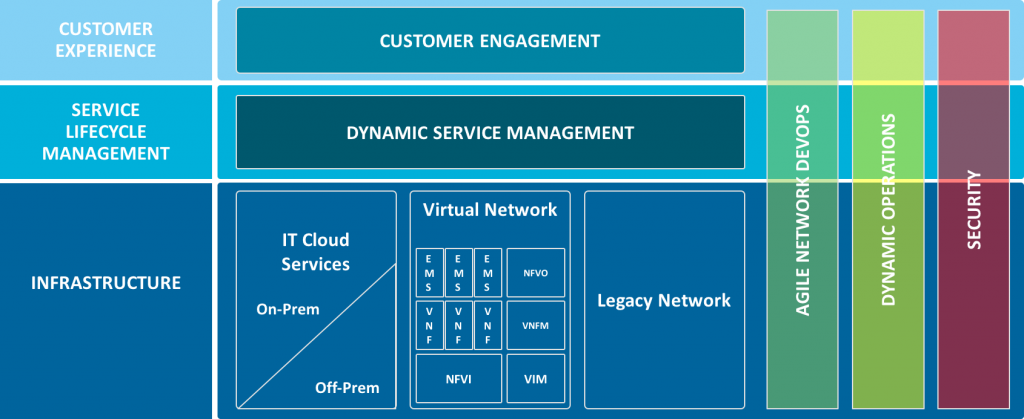
Digital Service Lifecycle Management (DSLM) architecture
In an earlier blog, I explained why this needs to happen. B2B and B2C customers today want personalisation, convenience and instant gratification in the purchasing process. Operators need to evolve their infrastructure to deliver better customer experiences to stay competitive, and network virtualisation gives operators the agility and flexibility they need to do so.
The key to introducing new capabilities gradually – since complete network overhauls aren’t practical for most operators – is to introduce “islands” of NFV capabilities into the network. On top of that, fresh approaches to managing the interconnection between physical and virtual resources will ensure operators can achieve this agility quickly, and at minimal cost.
In this post, I’ll explain just how you do that.
What is Digital Service Lifecycle Management
Comptel first introduced DSLM in our white paper – Digital Service Lifecycle Management: How CSPs Can Play a Successful Role in the Digital Economy. As Heavy Reading analyst Caroline Chappell wrote, operators today face competition from cloud-born companies like Google and Amazon, which have the infrastructure flexibility to spin up attractive new digital services much faster than the average operator.
Portraying the future role of operators as aggregators of digital services (from which the average consumer and business could buy whatever services they need to fill out their “personal digital ecosystems”), Chappell said network evolution is required to enable “on-demand personalised service creation.”
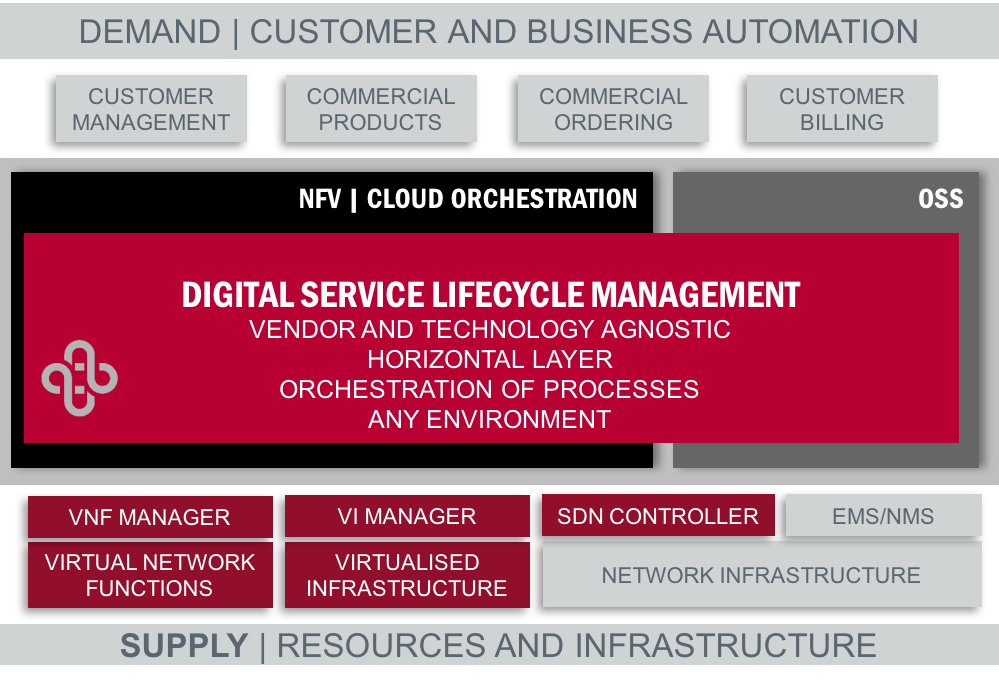
Digital Service Lifecycle Management (DSLM) layers
DSLM is how you evolve the network. It’s the middle portion of a three-tiered system that decides how virtual and physical network resources are managed to support service requests from front office systems.
How the Three-Tiered DSLM Model Works
This NFV-driven model requires three layers: one for resource management, one for digital service lifecycle management and one for business management.
The customer only ever sees the business management layer, which sits at the top and comprises the shopping environment, order configuration and payment tools. Customers configure and purchase services available through a digital catalogue, and automated ordering and billing capabilities ensure customer requests are quickly passed on for configuration and fulfillment.
The middle digital service lifecycle layer manages service composition through the service orchestration tool and the digital service catalogue. At this level, each new customer order is automatically checked for feasibility and availability, based on digital service definitions, service level agreements and inventory. That improves order quality and eliminates false service availability promises, which cuts down on customer dissatisfaction and the risk of order fallouts.
The resource management layer sits at the bottom and includes the infrastructure management tools and controllers that support physical and virtual network functions. When a customer inquiry for a new digital service arrives, this layer determines how best to deploy resources to fulfil that request.
With this NFV-driven model, operators can offer B2C and B2B customers alike a fast, accurate and automated, self-service buying experience. The digital catalogue can be scaled to include any new service, from your standard consumer or business IT and communications services, to network functionality, to IoT connectivity, to third-party SaaS solutions. That means operators can add to their capabilities as the digital economy grows and consumer demand evolves.
Where DSLM Fits in to IBM’s Cloud-Based Network
We brought our DSLM model to the IBM partnership, and it’s supported by FLOWONE, our service orchestration solution. Sitting in the middle between IBM’s Omni-channel Customer Engagement, and on top of a range of resource services and infrastructure tools that include Juniper’s NFV orchestration and infrastructure management solutions, it brings our vision for NFV-based fulfillment to reality.
The IBM Cloud-based Networking architecture was introduced recently at TM Forum’s Live! event but you can read more in the IBM Blog by Steven Teitzel, Telco Global Solution Exec – Network Transformation, IBM.
We invite you to visit Comptel at the Light Reading Big Communications Event in Austin 24-25th May to learn more about the Comptel model for dynamic digital service lifecycle management. Email [email protected] to schedule a meeting. Alternatively follow our updates and activity on Twitter (@shateley & @Comptelcorp) or via our LinkedIn feed.
You can also read more about the initiative from Comptel’s Simon Osborne, or catch up on our view of digital service lifecycle management through Nexterday.org, our online magazine and reader community.
Posted: May 6th, 2016 | Author: Steve Hateley | Filed under: Events | Tags: Intelligent Fast Data, Monetisation, NFV, OSS, service orchestration, TM Forum Live! | No Comments »
Technology partnerships are crucial to innovation in telecommunications. At next week’s TM Forum Live! 2016, Comptel will demonstrate the outcome of several recent industry collaborations, all of which are designed to introduce new approaches to digital service delivery, customer engagement, data monetisation and networking.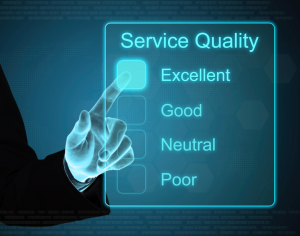
Comptel is taking part in three distinct partner-driven initiatives, including two TM Forum Catalysts, individually led by Telefonica and Orange; and an IBM-led digital service architecture blueprint. The ultimate objective of each initiative is to open operators’ eyes to new possibilities for infrastructure management, service delivery and offer creation through NFV service orchestration and intelligent fast data management.
Our contributions vary by project. In two of the cases, we’re putting the digital service lifecycle management (DSLM) model that we introduced in Nexterday: Volume II, with our FLOWONE service orchestration technology, managing forward-looking approaches to service delivery. In the third project, we’re supplying expertise and technology in the creation of a new, progressive data monetisation strategy.
Forward-thinking approaches are crucial at a time when customers desire fast, intelligent, personalised offers. Operators are also keen to take advantage of dynamic, intelligent, highly automated and virtualised network environments to speed up innovation, time-to-market and to improve security.
Here’s what you can expect from each partnership, with guidance on how you can learn more and engage with Comptel and our partners at TM Forum Live! 2016.
IBM’s Target Architecture for Cloud-Based Networking
Comptel, IBM and Juniper Networks have developed a new approach to digital service delivery for B2B and B2C customers, incorporating an orchestration and fulfillment architecture that allows operators to better manage end-to-end service lifecycles in complex hybrid networks of virtualised and non-virtualised services.
The architecture is based on our DSLM proposition, which you can read more about in a recent blog from our CTO Simon Osborne. The end-game is a network that’s able to automatically and dynamically deploy network capabilities and agile services in a way that gives customers automated, self-service digital service purchasing and delivery.
To learn more, visit the IBM booth at TM Forum Live!
Open Source NFV Service Orchestration and Lifecycle Management Catalyst with Telefonica
Comptel is also participating in two TM Forum Catalysts, which are proof-of-concept initiatives that encourage technology partnerships in the name of industry innovation.
The first is the NFV Service Orchestration and Lifecycle Management based on Open Source MANO Catalyst – sponsored by Telefonica. Along with Indra and Etiya, the initiative centres on Open Source MANO (OSM), an ETSI project to develop an open source stack for NFV management and orchestration, demonstrated here within a hybrid network environment.
DSLM also plays a crucial role in this Catalyst, as does our FLOWONE V service orchestration solution. The aim is to test the OSM software stack in a practical context and analyse how it needs to evolve to be production-ready.
To learn more about this Catalyst, join Telefonica and Comptel for our theatre session on Tuesday, May 11, 14:30-14:50 at the Catalyst Theatre.
Orange’s Catalyst on a Mobile Sponsored Data Business Model
Finally, Comptel will take part in an Orange-championed Catalyst, “New Business Models with Mobile Sponsored Data,” which also includes partners Salesforce and CloudSense, plus Sigma Systems and DataMi. We’ve contributed our Intelligent Fast Data technology and capabilities to illustrate how enterprises can sponsor mobile customer data usage as a way to incentivise the use of enterprise digital services, increase data engagement, collect usage data and apply policy control.
To learn more about this Catalyst, attend our session titled “New Business Models with Mobile Sponsored Data” at the Catalyst Theatre on Wednesday, May 12, 13:40-14:00.
Comptel is proud to partner with each of these technology leaders in collaborative efforts to introduce new solutions to communications. Whether it’s by improving digital service delivery through new infrastructure models, further developing OSM, or enhancing customer engagement through the creation of new business models, we’re excited to pioneer digital transformation. We can’t wait to share our progress with attendees at TM Forum Live! 2016.
Visit TM Forum’s Catalyst Zone to see these Catalyst demonstrates in action. To arrange a meeting with Comptel at TM Forum Live! 2016, email [email protected]
Learn more about the orchestration capabilities of Comptel’s FLOWONE and download a copy of the Comptel and Heavy Reading research report, “Digital Service Lifecycle Management: How Communications Service Providers Can Play a Successful Role in the Digital Economy.”
You can also learn more about how Comptel is enables operators and global enterprises to act on Intelligent Fast Data in our recent Intelligent Data webinar.
Posted: May 5th, 2016 | Author: Steve Hateley | Filed under: Events | Tags: IBM Cloud-Based Networking, NFV, OSS, service orchestration, TM Forum Live! | No Comments »
It’s a really good time to be a shopper. The world’s top ecommerce marketplaces, like Amazon and eBay, make it easier and faster than ever for consumers to buy whatever they want on any device, at any time. Top brands are also striving to offer a better buying experience – you can go on Nike.com right now and fully customise and order your own pair of shoes without leaving your couch.

Personalisation. Convenience. Instant gratification. Customers want it all, and technology means top brands are able to deliver. As a result, we’re operating in a new digital economy, one that’s driven by personal choice and an experience-led approach.
So why are many operators still struggling to deliver a convenient, automated and engaging customer experience?
The digital service purchasing process needs to evolve, and since we first discussed this topic in last year’s Operation Nexterday, we’ve heard some great success stories from operators who are undergoing that transformation. But we’ve also heard from operators who need guidance devising and launching a new model for digital service delivery.
That’s why, at next week’s TM Forum Live!, we are launching a proposed architecture for digital service delivery in partnership with IBM and Juniper Networks. The IBM platform for Cloud Based Networking (CBN), intends to maximize the agility offered by network function virtualisation (NFV) and software-defined networks (SDN) to create a better model for service delivery in the digital age.
What NFV/SDN Can Do for Digital Service Delivery
As I wrote in a recent LinkedIn Pulse piece, the virtualisation of networks and services empowers operators to present customers with the right services at the right time. That’s because NFV and SDN offer the infrastructure agility and flexibility to rapidly create new digital services, including their operational aspects, at maximum speed and minimum cost. In other words, NFV and SDN allow operators to move fast enough to create a more immediate and satisfying digital customer experience.
Of course, given that the embrace of NFV technologies won’t happen overnight, this vision doesn’t require a dramatic shift to a fully virtualised network. Instead, operators will deploy NFV capabilities as “islands” within their infrastructure, leveraging existing physical resources and associated OSS/BSS platforms as part of a hybrid approach for some time to come.
The Comptel/IBM/Juniper initiative, which is built in accordance with the Comptel Digital Service Lifecycle Management (DLSM) model proposed in Nexterday: Volume II, takes this hybrid approach into account. Designed as a three-tiered architecture, DSLM relies on a central orchestration layer that manages requests from the top customer engagement and business management layers, and supports those requests with appropriate resources from the bottom virtual and physical resource layer.
Each layer works together to deliver automated order validation, self-service customer configuration and intelligent resource management for easy scalability.
Creating Reality from New Digital Service Possibilities
How would this all be exposed to the customer? Through a better digital buying experience.
Customers should now be able to self-configure and order a broader range of services from a digital catalogue, and the operator’s infrastructure would handle the automated creation and immediate fulfillment of those services.
In the enterprise world, businesses looking to add on a new IT or communications service will be able to abandon the legacy linear purchase process that’s plagued by lengthy requirements reviews, proposals and bids which lead to delays, fallouts or generic IT implementations. Instead, much of the enterprise sales process will be automated, helping operators improve experience and sales.
The model creates a foundation for operators to easily grow and deliver a wide range of new service capabilities. With NFV, operators are able to assume the role of digital service aggregators, setting up marketplaces for B2C and B2B buyers to purchase existing and emerging digital services. For enterprise customers, that might even mean buying the very virtual functions they need to provision their own networks.
Ultimately our partnership with IBM and Juniper aims to reveal the business potential of virtualised networks when applied to service delivery – and how it unlocks new possibilities for operator service growth.
We invite you to visit the IBM booth at TM Forum Live! in Nice, France, from 9-12 May to learn more about the IBM Cloud Based Networking initiative and our model for dynamic digital service delivery. Email [email protected] to schedule a meeting.
You can also read more about the initiative from Comptel CTO Simon Osborne, read the Heavy Reading white paper or catch up on our view of digital service lifecycle management on Nexterday.org, our online magazine and reader community.
Posted: April 25th, 2016 | Author: Special Contributor | Filed under: Events | Tags: digital service lifecycle management, NFV, OSS, service orchestration, TM Forum Live! | No Comments »
By Simon Osborne, CTO Service Orchestration, Comptel
In the world of telco, emerging back office technologies – especially network functions virtualisation (NFV) – appeal to operators not just because of the promised evolution of infrastructure management, but also because of the potential difference these technologies can make to the bottom line.
It all starts and ends with digital services. We’re living in an app-driven world, where consumers build personalised ecosystems of apps and over-the-top (OTT) content. These customers are on the search for apps and services that solve specific problems or meet their unique needs, from personal health to entertainment and everything in between.
Businesses are the same way. Not only do companies want access to a wider range of digital capabilities – video and Web conferencing, cloud-based email and productivity software, connectivity and security services – but they also now expect a B2B buying experience comparable to the speed and personalisation they receive as B2C digital buyers.
How can operators deliver personalised, engaging service experiences to B2B and B2C customers? Through a conversational and automated service orchestration and fulfillment framework.
Comptel is partnering with IBM and Juniper Networks to develop just such an architecture. As a participant in IBM’s Cloud Based Networking (CBN) initiative, our aim is to leverage SDN and NFV technologies in the creation of an agile, self-service model for service configuration, validation and completion. We’ll share our new revision for OSS and dynamic digital service delivery with attendees and booth visitors at TM Forum Live! in Nice, France from 9-12 May.
Extending the Potential of NFV and SDN
Technologies in isolation don’t really change much about the state of play. The same is true for NFV. There’s nothing inherently disruptive about having a virtual version of a network function. Adding a “v” in front of OSS won’t mean you’ve revolutionised your business. It’s really about how you’ve applied that new technology to meet customer demands.
The real value of NFV is that gives operators the agility and flexibility to consider new ways to serve enterprise and individual customers. With a highly scalable, agile and flexible network, an operator can dream up and launch the innovative problem-solving services their customers want. In turn, the self-created apps and service ecosystem can drive new operator revenue streams.
The Model for Dynamic Self-Service Delivery
To bring this vision to reality, IBM is adopting Comptel’s Digital Service Lifecycle Management (DSLM) proposition. This NFV-driven model works across three layers: one for network orchestration, virtual function, IT and physical network management; a middle orchestration layer to manage end-to-end hybrid service orchestration and the digital service lifecycle; and a top layer for front-office customer engagement and business management.
Comptel’s FLOWONE V service orchestration solution will fulfil the central DSLM layer, while IBM and Juniper will provide the network domain and IT service orchestration, dynamic operations, customer engagement, DevOps and security applications and services. Through integration with a digital service catalogue, this three-tiered system is able to support fast and easy self-service product ordering and configuration at the customer level. The model accounts for automated validation to ensure service availability and feasibility, and includes intelligent resource management to ensure the system can scale for service demand.
In future blogs, we’ll dive into the market potential for this type of model and the technical aspects that make it possible. But for now, it’s clear to see the revenue possibilities for operators. With a smart, automated and self-service digital sales cycle, you empower customers to build their own personal ecosystem of digital services and apps. Agile NFV and SDN technologies let you deliver these capabilities at an attractive cost. Ultimately, this model presents an innovative way for operators to expand their service capabilities and unlock new revenue in the era of rising digital expectations.
Visit Comptel and IBM at TM Forum Live! to learn more about the IBM Cloud Based Networking initiative and our model for dynamic digital service delivery. Email [email protected] to schedule a meeting. You can also read more about digital service lifecycle management at Nexterday.org, our online magazine and reader community.
Posted: April 19th, 2016 | Author: Malla Poikela | Filed under: Events | Tags: Monetisation, policy control | No Comments »
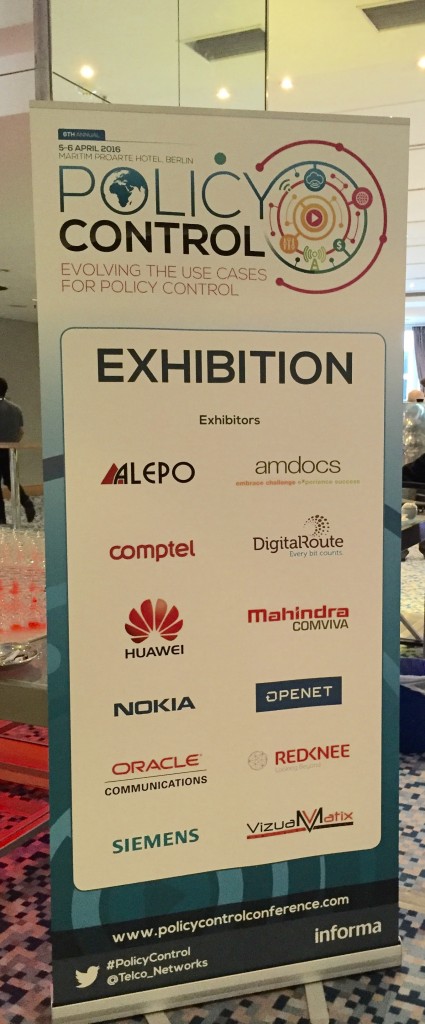 Policy control cannot be seen as a standalone function any longer. It needs to be combined with charging and predictive analytics to give customers the best, most contextual and personalised service experience. At the same time, effective policy and charging control also gives operators the flexible and agile tools they need to monetise data services. That was one big takeaway from the Policy Control Conference 2016, which bills itself as the world’s only event exclusively dedicated to the policy control market.
Policy control cannot be seen as a standalone function any longer. It needs to be combined with charging and predictive analytics to give customers the best, most contextual and personalised service experience. At the same time, effective policy and charging control also gives operators the flexible and agile tools they need to monetise data services. That was one big takeaway from the Policy Control Conference 2016, which bills itself as the world’s only event exclusively dedicated to the policy control market.
Nearly 200 policy control enthusiasts from 80 organisations gathered at Berlin’s Maritim proArte hotel from 5-6 April to learn about the latest and greatest developments in the field of policy control. The entire policy control ecosystem was represented, with scheduled presentations from solution vendors, operators and industry analysts. Executive speed networking, operator-hosted lunches, analyst breakfast roundtable briefings and operator and vendor dinner also offered plenty of opportunity for interaction.
Comptel was in attendance as a sponsor, and we also hosted “The Seven Deadly Sins of Policy Control,” a session with our VP MONETIZER Simo Isomäki and our VP Solution Architecture Martin Vieth. We highlighted the defective, broken aspects of policy control that needed to be corrected as operators evolve toward a modernised and future-proof policy environment. At the event, attendees heard how operators are addressing challenges like time to market, increasing customer experience demands and the introduction of virtualised functions into the network through innovation policy control management. Here are several big takeaways from the event.
Complexity Slows the Speed of Innovation
Network agility is crucial to delivering the flexibility operators need to achieve a higher speed of service creation, which is a valuable asset at a time when monetisation opportunities crop up at a moment’s notice. However, overly complex telco networks slow everything down, making it difficult or in some cases impossible for operators to configure and launch new services fast enough to attract customers at their peak moment of interest.
Simo and Martin explained that the blame lies with complex and scattered network architecture and management, which kills innovation. As a result, many operators are “dead slow” – 69 per cent of CSPs say launching a new product or changing a product takes too long, according to Heavy Reading. The right environment and toolset could speed things up by giving operators a single view to create and change products and allow for service creation experimentation. Operators should strive to innovate when it comes to service pricing, add-on apps, data bundle configuration, delivery speed and more to appeal to digitally savvy customers.
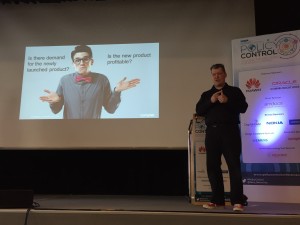 NFV and Policy Control
NFV and Policy Control
Network functions virtualisation (NFV) is, naturally, one key area of innovation affecting policy control. PCRF is often one of the first network functions to be virtualised as operators seek to respond quickly to changing market conditions.
Many telcos in attendance acknowledged the benefits of NFV, including its ability to drive a 95 per cent improvement in service cycles, outweighed the potential challenges of implementation. Presenters argued that policy control and analytics should be tightly integrated with network and service orchestration, delivering service and customer awareness to the NFV and SDN network.
At the same time, the Comptel presentation emphasised simplicity above all in NFV implementations. Operators are striving towards NFV – one said “If you don’t do NFV, you’ll be left behind”. In our session, Simo and Martin advised a hybrid approach in which brand-new NFV infrastructure and legacy environments work in cooperation to maintain simplicity.
Analytics Enables Better Service Experience
Another major theme at the show involved the central role customer experience should play in policy and charging control management decisions. For example, moving away from the idea of standalone policy control and toward a vision for natively combined policy control, charging, predictive analytics and real-time business reporting helps operators deliver a better and more targeted end-to-end service experience.
One operator described how they currently analyse customer usage behaviour and patterns with a Big Data cognitive learning analytics platform. Using that data, they can guide their policy engine for example to offer the best service with the most attractive apps to customers. Predictive analytics also informs service testing, so that operators can test and affirm a new services’ success before launching it publicly.
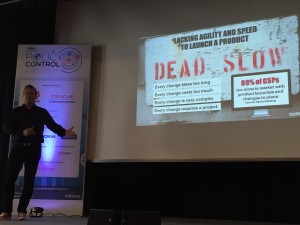 The Customer is at the Centre of Service Experience
The Customer is at the Centre of Service Experience
Forward-looking service creation puts the customer at the centre by selling services the way buyers want. As Fredrik Jungermann explained at Nexterday North 2015, customers buy data by the bundle today only because that’s the way operators choose to sell data, but that doesn’t mean it’s the only way or the perfect way to sell data. Rather than simply selling data on a small, medium, large or extra-large model, Simo and Martin advocated a model where data is flexibly bundled with attractive over-the-top (OTT) content services to appeal to the customer’s preference.
Additionally, there were discussions around the importance of offering consistent mobile service experience no matter the customer’s location. Presenters argued that there is value in policies being access-neutral whether a customer is on fixed internet, mobile data or a Wi-Fi network.
Similarly, operators could change the way the allocate bandwidth per application to improve service experience. Twitter and Netflix, for example, don’t need the same bandwidth speeds to run successfully, but that is currently how those apps are supported by many internet service providers. Why not flexibly support apps with an appropriate level of bandwidth, reserving the best speeds for live streaming videos?
Ultimately, that’s how operators and the industry need to think about policy control moving forward. The customer should always be at the centre of any major innovation in the network or otherwise, so an evolution in policy and charging control should likewise focus on improving the customer experience. Since complexity is the enemy of innovation, operators will need to only consider transformation that can make things work more simply and quickly.
Learn more about the tools how to monetise more in less time: Download our whitepaper about the MONETIZER™ or register to our MONETIZER™ webinar or click to read about our MONETIZER™. To keep up on the latest news and discussion topics, please join our Magazine and Reader Community in nexterday.org.
Posted: April 12th, 2016 | Author: Joakim Knutar | Filed under: Industry Insights | Tags: big data, ETNews | No Comments »
ETNews organised a Big Data Seminar in Seoul on 22-23rd of March. Several hundreds of experts from the Big Data field came together to hear about great ex
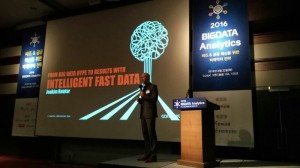
amples and technologies, and to share experiences. Comptel had the pleasure of joining Team Finland with a speaker slot together with IOT specialists BaseN and Wirepas.
So what created most buzz?
Nokia had the opening keynote talking about internal and external data, and how all data should be used to improve predictions. Interesting IOT areas were energy, digital health, and connected cars. Also emphasised was privacy and how all connected devices will bring further challenges when it comes to privacy matter.
A very interesting keynote was given by famous designer Youngse Kim. He explained how it will be difficult to drive consumer value out of data unless you have Big Design. He explained how consumer design is all about predicting and how this focus on big data will drive momentum into the design-space as well. Mr. Kim further noted that big data and IOT will only be commercialised because of Big Design. New industries will emerge. The design will be at the center of new business for companies who succeed. A good example were two designers who wanted to design hotels, but went on a sidetrack and created Airbnb.
The retail side was represented by Tom Spencer from dunnhumby. Key takeaways were how they use big data to create loyalty, and the need for a Chief Data Officer in every organisation. He also showed how everyone need to climb the analytics capability ladder before they will truly be able to turn data into value.
With the growing complexity of data gathering, analysis, and exchange we cannot but agree with Mr. Spencer on the fact that most organisations today lack a person in charge of a good vision for big data and strategy.
ShinhanCard showed very interesting figures and examples on how they have been able to grow their business with big data. With 22 million members they discovered that they needed to segment their customers and create segment specific credit cards. Today they have 11 different cards. They also talked about how they used real-time data to help the government at the time of the MERS outbreak last year. Or what do you think about analysing how far people are willing to travel for cheaper products? Or using mobile phone credit rating data to give loans?
Another hot topic to be noted was real-time analytics. Most of the presentations had some degree of real-timeless in them, and it was great to see that Comptel is not the only one who have realised that the best way to value from data comes from Intelligent Fast Data.
I had the honor of presenting Comptel’s Intelligent Fast Data and how to get value out of data using real-time analytics and actions. Our Nexterday was, of course, part of the story, and it is interesting to see that Nexterday is really cross-industry. Not only for Telco, but for IT in general and any industry who need to serve their customers better. Remember, focus your customer, not customers.
It seems that contextuality is really picking up. Meaning that it is understood that data is most valuable when it is fresh and used at the moment. This becomes even more critical when moving into IOT. So the question is: Is your infrastructure equipped for Nexterday?
As part of the Team Finland delegation, we also had a chance to have separate meetings with many interesting companies. Truly inspiring to see what is going on in Korea and the potential that is there. To be continued…
Posted: April 5th, 2016 | Author: Ari Vänttinen | Filed under: News | Tags: Operation Nexterday | No Comments »
For more than a year, Comptel’s Nexterday movement has pushed forward the conversation around digital transformation in telecommunications. Now, it’s exciting to see the movement catch fire outside our industry and gain recognition from leading experts in digital media and communications.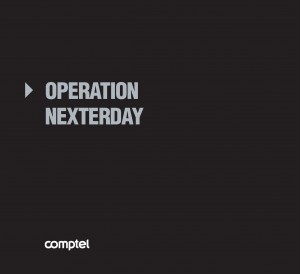
We’re honoured that Business Intelligence Group named our first book, Operation Nexterday, as one of the top campaigns of the year as part of its 2016 Public Relations and Marketing Excellence awards. The awards recognize leaders in the field of strategic communications and our book’s inclusion in the awards highlights its value in effectively communicating our vision for the future of telecommunications.
In Operation Nexterday, we set out the game plan for how operators can radically update their sales, marketing and service strategies in response to customers’ increasing digital service demands. With contributions from industry experts and Comptel thought leaders, our book challenged the current way of working and described how and why operators must change.
Though we’re proud Nexterday is being recognized worldwide, we know our work isn’t done yet. That’s why we published a second edition, Nexterday: Volume II, to dive deeper into the topic of digital transformation and offer blueprints on how operators can take the next step. That follow-up edition included even more insights from within and outside telco and set a course for how each operator can become a perfect digital company that works for and with its customers to meet their needs.
Additionally, Comptel’s 2016 plans focus on growing the Nexterday movement. Our Nexterday Tour returns this summer, when we’ll hit the road to bring our message to regional decision makers and partners in 20 cities across the world. Everything leads up to Nexterday North 2016, our encore to last year’s inaugural anti-seminar, where we plan to introduce new voices and ideas to create an even richer, more dynamic and inspiring event.
We’re thrilled to see continued excitement around Nexterday, and we’re eager to spread the word even further. To learn more about the campaign that started the movement, click here to download Operation Nexterday. You can also read articles from Nexterday: Volume II and learn more about digital transformation in telco and beyond at Nexterday.org, our online magazine and reader community.
Posted: March 2nd, 2016 | Author: Malla Poikela | Filed under: Events | Tags: analytics, big data, customer experience, Mobile World Congress | No Comments »
This year’s Mobile World Congress (MWC) was another exciting one for Comptel. We launched a new book, Nexterday: Volume II, and Nexterday.org, an online magazine and reader community, threw a party, and met with many operators who were interested in learning more about transforming their business to address the demands of digitalisation, as well as partners, analysts and media. When it comes to effectively transforming to a digital company, one of an operator’s biggest assets is customer data.
A consistent theme throughout MWC 2016 was the idea that operators are sitting on a store of customer data that, like an untapped oil reserve, could deliver rich insights that lead to significant revenue opportunities. Rising interest in the Internet of Things (IoT) isn’t making matters easier – we saw a flood of manufacturers demonstrating their latest connected devices, from cars to wearables, at MWC 2016, plus a fair share of big thinkers promoting their vision for larger-scale, IoT-enabled operations, like smart cities. Here are takeaways from the MWC panel “Operator Customer Analytics,” where those challenges and opportunities were discussed.
The Operator Perspective
 Operators have always collected data, but the ways in which they pool, interpret and act on information has changed as technology and processes evolve.
Operators have always collected data, but the ways in which they pool, interpret and act on information has changed as technology and processes evolve.
Kuan Moon Yuen, CEO of the consumer group at Singapore-based operator Singtel, explained that his company has developed a more sophisticated analytics estate by pooling insights from multiple data sources. Customer data usage has always been important to telcos, but Singtel stressed that analysing other information – location, device and real-time contextual metrics – allows operators to deliver tailored network optimization, better customer support and predictive, real-time marketing.
Dr. Jiwon Ashley Joo of SK Telecom agreed that context changes the way operators can serve customers. Her company changed its analytics framework to gain a more holistic view of how its customers interact with various services. This type of observation led to service innovation, including a popular new connected wearable device for kids and pets. As these new services are used, the operator collects even more information about its users, which inform future initiatives.
The Standards Association Perspective
 Of course, it’s easy enough to point out operators’ need to mine, interpret and act on their substantial data reserves. Rob Rich of TM Forum clarified the challenge by reminding MWC panel attendees of the significant skills gap that prevents many operators from actually putting these ideas into practice.
Of course, it’s easy enough to point out operators’ need to mine, interpret and act on their substantial data reserves. Rob Rich of TM Forum clarified the challenge by reminding MWC panel attendees of the significant skills gap that prevents many operators from actually putting these ideas into practice.
Of the substantial volume of data currently floating out there in operator environments, a small percentage – about 5 percent, said Rich – is actually actionable. To increase that percentage, operators need to develop an organizational culture for sharing data, and raise their level of sophistication when it comes to leveraging data.
That underscored what’s perhaps the biggest challenge operators face in maximizing customer data: they’re already a bit behind the eight-ball. For digital-born companies like Google and Facebook, a data-centric culture, mindset and competency is already built-in. Telcos need to change to acquire some of those qualities.
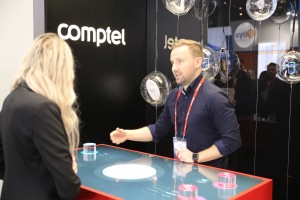 The Customer Engagement Automation Solution Perspective
The Customer Engagement Automation Solution Perspective
So, if the objectives are to combine multiple insights from disparate data sources, get smarter about how your organisation manages and analyses data and change the culture of your organisation to be more data-centric, what’s your next step?
Third-party partnerships can help operators improve their level of sophistication around analytics initiatives, even democratising analytics insight, so anyone from IT to marketing to sales can make smarter decisions about customer information. Analytics platforms bring together raw data from multiple sources, enrich it to provide context and drive the right actions instantaneously. These solutions enable automated and real-time decisions and actions, helping businesses keep pace with fast-changing buyer needs and wants.
The biggest opportunity here is in real-time and contextual marketing: an operator who learns a customer is running low on mobile data while that individual is listening to a streaming music app has the chance to deliver a highly relevant and compelling top-up offer at the perfect time. It’s how marketing can and should work if you’re able to act in real-time with the right information about your customer.
Learn more about how successful operators leverage customer analytics data in our new book, Nexterday Volume II.











 Policy control cannot be seen as a standalone function any longer. It needs to be combined with charging and predictive analytics to give customers the best, most contextual and personalised service experience. At the same time, effective policy and charging control also gives operators the flexible and agile tools they need to monetise data services. That was one big takeaway from the
Policy control cannot be seen as a standalone function any longer. It needs to be combined with charging and predictive analytics to give customers the best, most contextual and personalised service experience. At the same time, effective policy and charging control also gives operators the flexible and agile tools they need to monetise data services. That was one big takeaway from the  NFV and Policy Control
NFV and Policy Control



 Operators have always collected data, but the ways in which they pool, interpret and act on information has changed as technology and processes evolve.
Operators have always collected data, but the ways in which they pool, interpret and act on information has changed as technology and processes evolve.





